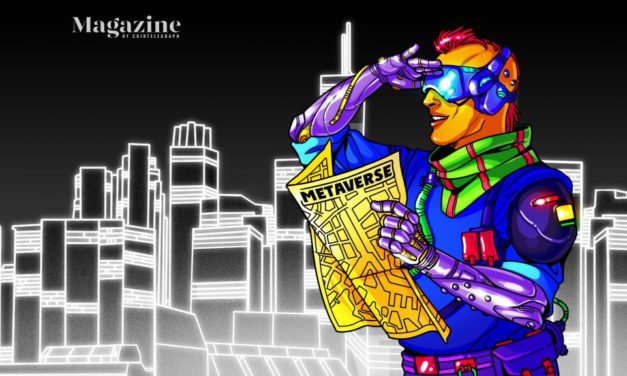Billions are spent marketing crypto to sports fans — Is it worth it?
Crypto advertising has been plastered across every available sporting surface since the bull run of 2021, from stadium naming deals and team’s playing kits to Formula One racing car liveries. But in the current bearish market conditions, it seems hard to calculate a return on the ubiquitous spending of 2021’s crazy big advertising. In Australia, where I’m based, there was a sharp uptick in crypto firms spending big on ads and sponsorship deals in the Australian Football League in 2021–2022. While it may make sense for a local crypto exchange, why would a global project spend big dollars on a sport that isn’t even the major football code in every state, given some of the bigger states prefer the National Rugby League?Take, for example, the Staples Center in downtown Los Angeles, home of the National Basketball Association’s Lakers and Clippers, the National Hockey League’s Kings and the Women’s National Basketball Association’s Sparks. It got a new name on Christmas Day 2021 — Crypto.com Arena — for a reported $700-million dollar deal. Are crypto projects wasting money on big sports deals?While financial terms of the 20-year deal weren’t publicly announced, it is believed to be the most expensive naming rights deal in sports history. Time will tell if it was money well spent. As the home court where the late Kobe Bryant played basketball, many today will still call it the Staples Center indefinitely, but a younger generation likely will not. Crypto.com wasn’t the only brand spending up big on sports deals.VeChain paid $100 million to plaster its logo throughout the Ultimate Fighting Championship arenas. Will getting the barely recognizable logo in front of kickboxing fans on TV lead to any new customers for its supply chain tracking solutions or onboard new users into the crypto ecosystem?You can’t miss the prominent VeChain branding at the UFC. Source: TwitterIs this all just wasted expenditure born of a bull market or a clever long-term commitment to advertising crypto adoption? It depends on who you ask. There have been a few backhanders from notable crypto figures toward the practice.In June this year, Crypto.com announced a 260-employee lay-off, equating to a 5% cut of its workforce. Binance founder Changpeng “CZ” Zhao tweeted, “It was not easy saying no to Super bowl ads, stadium naming rights, large sponsor deals a few months ago, but we did. Today, we are hiring for 2000 open positions for #Binance.”It was not easy saying no to Super bowl ads, stadium naming rights, large sponsor deals a few months ago, but we did.Today, we are hiring for 2000 open positions for #Binance. pic.twitter.com/n24nrUik8O— CZ ? Binance (@cz_binance) June 15, 2022Not all sports sponsorship deals are of dubious value, however, and marketing experts in the space say crypto marketing spending can be justified depending on crypto market product segmentation and brand authenticity.Wasted expenditureChris Ghent, head of brand strategy at the Near Foundation — a climate-neutral sharded blockchain project — has tipped funds into sports sponsorships but also believes that they can be a huge waste of money if done wrongly. “Historically, crypto projects beyond exchanges have ignored paid media. And without explicit use cases tied to the massive dollars paid for sports marketing sponsorships, the branding only leads to logo exposure.” For these huge sports sponsorship deals, the metrics to determine the returns are unclear. But as exchanges are the gateways to crypto adoption, aren’t they doing everyone else in the industry a favor by spending big to onboard new retail users from the mainstream sports community? Yes, says Ghent, “but sports sponsorship of a significant amount is reckless. Terra sponsoring the Washington Nationals — what good is that doing today?” He’s referring to Terra’s major sponsorship of the baseball franchise in the United States capital. It signed a five-year, $38.15 million deal with the Nationals paid upfront in cash. Then, Terra collapsed. Bad press for all concerned, though, at least the team gets to keep the money. This year there are 10 F1 motorsport teams, and crypto companies sponsor eight of them. It can be argued that is smart marketing. Research by global analytics company Nielsen Sports found that F1 has the potential to reach about 1 billion fans globally, with the 16–35 age group accounting for the biggest share. The market segment sponsorship logic there is apparent though whether that justifies the exorbitant cost is another matter.Some sports sponsorships can be value for moneyGhent argues that carefully chosen sponsorship deals that are deeply integrated partnerships can be value for money if they are designed with authenticity. The Near Foundation has begun sponsoring sporting properties such as SailGP F50 catamaran sailboat racing. The value of that deal is undisclosed.Ghent insists the SailGP spending is not reckless in the way some might argue crypto exchange Bybit sponsoring Red Bull’s F1 Racing Team in a three-year $150-million deal is, for example.8️⃣ out of ? teams on the grid has a Crypto-based company as a sponsor this season ?Here’s a look at which teams have crypto partnerships for 2022 ?#F1 #F12022 #Motorsport pic.twitter.com/hN6UfSIrWC— Motorsport.com (@Motorsport) March 2, 2022Ghent suggests that instead of slapping a logo on something, Near has bought the ability to integrate the protocol into the sport. SailGP is a modern version of the famous America’s Cup with F50 carbon fiber boats. All the boats competing are on a level playing field with consistent design and open-source data sharing via Oracle Cloud. So, races reflect the pure skill of the athletes — unlike F1 racing where only the best-funded teams can realistically win the championship. Through the partnership, SailGP is launching a DAO-owned race team on the Near Protocol. The DAO community members would be able to participate in athlete selection, team management, commercialization options, operations and team strategy. He says, “The best form of marketing is that the superfans become your best advocates. The Near brand is inspiring what happens with the technology.” Logically, fan-based DAO ownership means skin in the game and organic marketing engagement directly with sports fans. Ghent tells Magazine the DAO-managed team is on course to launch this season. Sports-team-owning DAOs are, of course, experiments, but the takeaway is that authentic marketing in crypto means being seen as staying true to crypto culture while finding a wider market segment.WAGMI United raised millions in a few hours with its NFT collection.You could say that’s like the open-source boat designs as opposed to centralized private racing car teams with grossly unequal budgets.Something similar is also being done in the fourth tier of United Kingdom Football by Crawley Town FC, which was purchased by crypto group WAGMI United in April, and is planning to create a DAO-managed team, too.And in July, they signed a new player, midfielder Jayden Davis, after an NFT-powered vote.The small club also sold more than 10,000 NFTs this year in stark contrast to soccer powerhouse Liverpool’s NFT collection, which sold poorly, perhaps to a lack of authenticity, and amounted to a marketing disaster. It seems the mission for Crawley Town to reach higher leagues of English football resonated with NFT buyers.Another sympathetic tie-up between a brand and a sporting event is Animoca Brands gaining the naming rights for the Australian Motorcycle Grand Prix and the Aragon events this year and next. Animoca is developing the official MotoGP blockchain-based game called MotoGP Ignition and no doubt relishes the chance to highlight the game in front of a worldwide audience of 400 million racing fans.Crypto guerilla marketing?In this context, relevance is key to a good marketing campaign for those crypto believers.“Guerrilla marketing in crypto is all about having contextual relevance,” opines Ghent. That is, the marketing is relevant to the nature of the product or protocol.In marketing parlance, guerilla marketing is lauded as a way to drive publicity and brand awareness by promoting the use of unconventional, less expensive methods, such as street art or flash mobs of dancing crowds.DAO-based ownership of intellectual property, such as PleasrDAO or ConstitutionDAO, is perhaps the best guerilla marketing. It’s all based on ownership and “ownership” securing the networks, notes Ghent. Ownership and DAO participation to a degree is the ultimate guerilla marketing. It’s not the token itself — it’s the ability of fans to feel even greater ownership over their favorite team. Marketing relevance in a bear market: EducationGeoff Renaud, chief marketing officer and co-founder of crypto marketing agency Invisible North, thinks the big sporting sponsorships are pretty hollow, with too much being spent for very little return. “With the big sports deals, there’s no real educational element. Early 2021 showed us unseasoned marketers spending too much. We saw so much unchecked spending on partnerships and no real measurement on impact.” He says, “The challenge is that most people speculating on crypto have no idea about the tech they are speculating on.” The questions need to be: Why have you invested in this? What do you believe in? They need to understand the products. The solution for crypto companies is education, especially in a bearish market. For example, how to make onboarding easier — at a marketing spending level. That means, at its most basic, teaching people how to set up a wallet and buy some crypto. Education is also crucial to keeping the community out of despair. “For high conviction in the long-term, education needs to be taken more seriously.” Renaud tells Magazine.“Marketing now is about getting people to stay in the game. The tourists will always leave.”Still, Renaud argues pure brand-building tactics have a place. He cites crypto exchange FTX partnering with Coachella in February to create NFTs as a good example. Ticketing and proof-of-attendance protocol, which are digital mementos of events, are now an accepted use case of NFTs with street cred. In this example, Coachella and FTX partnered to turn NFTs into lifetime passes to the famed music festival. 1) Really excited to be working with @coachella to release NFTs!https://t.co/MvgaqfmHqN pic.twitter.com/0iq0TZn9V3— SBF (@SBF_FTX) February 2, 2022Renaud also thinks that branded NFTs grounded in pop or sports culture have their place. “2021 also showed us that many retail investors needed a known brand to enter the space,” he says, pointing out that “NBA Top Shots was the ‘gateway drug’ for newbies.” But will brands be interested in crypto and NFTs as floor prices plunge and the community tips into despair? “In hype cycles, there is some value in just being there. But is that enough for the brand to stay for the long-term?” he says, adding, “As this is an exploratory phase, some conviction is required.” NBA Top Shots allows fans to own in-game moments.Part Two: Bear marketing for everyone elseFor those projects that have instead decided to focus on the grassroots levels, how do they approach marketing, especially during a bear market?There are segmented market demographics, so the first question is: Who are you marketing to? Crypto is full of cliques. From new adopters to play-arounders to the crypto-tragic degens. The degens will likely figure stuff out without any need for traditional marketing. Then there’s everyone else in-between on that spectrum. That’s why market segmentation is imperative. The next question is: What is your company selling? What are your goals or key performance indicators?Where you fit in crypto land dictates marketing forums and spending. Are you focused on customer acquisition or use case awareness? Are you selling a product or building an ecosystem? Traditional marketing practices are more obvious for crypto exchanges, such as Crypto.com, which compete for retail customers as an on-ramp to sell cryptocurrencies. Exchanges are also the most measurable mediums for marketing. So, the Staples Center deal may not seem that crazy over a 20-year horizon. But marketing layer-1 blockchains, such as Ethereum or Solana, means developer onboarding to that particular blockchain is the clear goal at this stage in development and a quantifiable return on investment marker.Bear marketing can be a real struggle. Source: PexelsDevelopers hate marketingIt must be noted that developers don’t like or need to be told what to think — they just need to know where to find the information. “Developers do their own due diligence. You can’t brainwash them — you need to give them the information they want,” says Austin Federa, head of communications at the Solana Foundation. “Developers hate being marketed to — that’s one thing most people misunderstand in this space. No amount of marketing will make developers build on your platform. They want great tooling, great documentation and a chance to be profitable on your platform.”Every layer-1 blockchain has a foundation, which promotes ecosystem development on that blockchain. Conviction is important, Federa explains. “Multi-year time horizons don’t affect our future. We are not afraid of spending money, but it must be on something that works,” he says.Federa explains that the Solana team operates like any startup with a “lean team, so budgets don’t change much with a bear market.” Spending is targeted. For example, the Solana Foundation runs hacker houses, which are like real-life bootcamps and are “expensive but valuable.”They know Solana’s target audience. “Marketers massively overthink it sometimes. Degens are only part of it. They are important to the crypto ecosystem, and they are committed traders and NFT collectors, but they tend not to be developers.”But what is cost-effective marketing in crypto, and does it work? Parking Lamborghinis outside crypto events in NYC? Again, the answer depends on who you are marketing to. Are you advertising the get-rich-quick dream or the decentralized change-the-world ideology? Federa simply suggests keeping the community informed with product explainers is cheap and effective. Value-added marketing for a layer-1 blockchain means product explainers. Federa tells Magazine that a good example is a two-paragraph new tech feature update in their regular email newsletter.“It sounds boring, but developers don’t care for and don’t need flashy marketing. For developers, we make sure they are aware of the resources that exist, and the message is specific to the tools that are available for their use.” “The best companies building on Solana hardly ever talk to us. Developers who need the constant hand-holding aren’t the ones who will build the next $2-billion DApp,” says Federa.Authentic clear messaging through ecosystem buildingNuanced authentic messaging is crucial, explains Ghent, who joined the Near Foundation in 2021, coming from a traditional media buying background. “Building a crypto brand is the best way to learn about how to help crypto projects to become seen and heard. Building an authentic brand leads to word of mouth — scaling ecosystems organically,” Ghent tells Magazine.Much derided during the ICO boom, when projects announced more partnerships than produced lines of code, Ghent says genuine ecosystem-building partnerships do matter.“For Near, partnerships are focused on product integrations, utility and community building. Cross-chain partnerships, for example, provide more opportunity than seen in traditional marketing.”That again is preaching to the converted, though, and crypto projects have a hard time telling succinct stories to the general public. There’s a lot of insider haughtiness. Part of crypto’s problematic narrative is, of course, that one market segment is literally authority-hating punks. “There are massive communication challenges — most crypto-marketers lean into the hype. It’s way too insider-focused. Organic social media and Twitter are seen as the be-all and end-all,” Ghent bemoans.He also notes that the origin story of many crypto marketers is not marketing. “Their background tends to be overly academic or product-focused, so it’s not natural for many to build a brand and communicate the right case studies in the right context.”Tokenized advertising a way forwardCompanies should focus on product utility, says Ghent, who cites Brave Browser, a private web browser that rewards users for viewing advertising, as a good example. Perhaps tokenization, then, is the best form of crypto guerilla marketing. Near partnered with Brave from alpha to today, so Ghent has seen their success up close. “Brave is founded by former Mozilla leadership, and to date, they have seen significant growth around a good product that relied almost only on organic marketing while naturally onboarding people to crypto.” He says this also points to tokenized advertising schemes having big potential.Solana hackathons advertised on Brave Browser.With Brave, “customer acquisition has less friction, as most users are crypto-curious, and the ad formats are more user-friendly. And since you’re rewarded for your attention, there’s more attention provided by the user to the advertiser.” “Brave is a great example of how to get people using a product in exchange for tokenized value in exchange for ad views.”Reckless sports marketing is a sponsorship, not a strategic integrated partnership, he argues.
Čítaj viac






